Expo Line picks up speed
March 24, 2011
As the first “road tests” begin on the initial phase of the new Exposition light rail project, a series of recent decisions is blazing the trail toward the line’s ultimate finish in Santa Monica.
A partial opening of the Expo Line from downtown Los Angeles to La Cienega is planned for this fall, with the conclusion of Phase 1 to Culver City expected next year. Meanwhile, work is beginning in earnest on Expo Phase 2, which will extend the line to Colorado and 4th Street in Santa Monica by 2015. (This interactive map shows the entire 15.2 mile route.)
Expo’s Board of Directors on March 18 voted to award the Phase 2 design-build contract to the firm Skanska/Rados. The board also voted to build an aerial crossing and station at Sepulveda instead of a street-level crossing, which was opposed by some neighborhood groups.
“Sepulveda is the major north-south thoroughfare on the Westside. Putting an at-grade crossing there is almost like putting an at-grade crossing on the 405 Freeway,” said Chuck Ray, co-chair of the Mar Vista Community Council’s Transportation and Infrastructure Committee, which backed the aerial option.
The elevated crossing and station will cost nearly $5.3 million more than the street level version. But the city of Los Angeles is picking up the tab for the additional cost, using money from the West L.A. traffic mitigation fund. (The motion by Councilmembers Paul Koretz and Bill Rosendahl is here.) The Phase 2 overall budget is $1.5 billion.
“This is an enhancement to the project. It will be a benefit to the project, to the city and to the Westside,” said Samantha Bricker, Chief Operating Officer for the Expo Line Construction Authority.
The Expo Board also voted in favor of the “no-parking” option at the Expo Line’s Westwood station. This option was preferred by some in the community, who feared that a proposed 170-space parking lot would draw too much additional traffic to their neighborhood.
“Putting a parking lot in the middle of our residential neighborhood is asking too much,” said Sarah Hays, co-chair of the group Light Rail for Cheviot.
Expo officials will be soliciting more public input for the Phase 2 design-build process at a series of community meetings in early May. (The dates will be announced soon.)
Meanwhile, the line’s Phase 1 progress was visible around USC earlier this week when a mock-up of a future Expo Line train (actually a flatbed pushed by something called a speed swing) took a ride on the tracks to make sure everything lines up properly with the station platforms.
Posted 3/24/11
Wave of tsunami prep heads our way
March 24, 2011
Add this to the list of potential catastrophes that come with living in Southern California: an earthquake-triggered tsunami washing over beaches and harbors and leaving devastation all along the coast.
The nightmarish images of powerful waves buffeting Japan after the March 11 quake there have prompted many to wonder whether the same thing could happen here—and how to escape it if it does. But some Los Angeles experts and planners have been focused on the local tsunami threat long before the first wave hit Japan.
And their assessment of what could be coming our way, and how best to prepare for it, is both simple and complex.
Costas Synolakis, who directs the Tsunami Research Center at USC, said tsunamis triggered by faraway events occur once or more a decade here, and generally pose a relatively minor threat to human safety in Southern California—although they can wreak havoc in the ports by damaging docks and disrupting shipping. A tsunami triggered by a large earthquake in Chile last year did just that, he said—though since it was a Saturday, its impact was less severe than it might have been.
However, a major temblor in the Aleutian earthquake zone in Alaska could pose a significant exception to the general rule about distant-source tsunamis. Such a quake could unleash a powerful tsunami that could endanger both people and property in low-lying coastal communities such as Marina del Rey, Venice and Long Beach, Synolakis said.
To better understand the possible impact of a hypothetical 8.8 quake in the Eastern Aleutian Islands, officials with the U.S. Geological Survey started work in January on their first-ever emergency planning “tsunami scenario” for Southern California. Modeled on the Great California ShakeOut, the scenario, when completed in 2013, will assess how such a tsunami would affect the region economically, environmentally and as an emergency response challenge. It also could serve as the basis for future tsunami response exercises.
Whether they end up causing minor or major damage, tsunamis that originate far away come equipped with one important safety feature: forecasters can see them coming, often hours in advance, allowing time to alert the public and evacuate beach areas likely to be affected.
A “local-source” tsunami would not be so kind. A tsunami triggered by a nearby offshore earthquake could trigger an underwater landslide, causing profound and fast-moving damage all along the Santa Monica Bay—with little or no time for evacuations.
“The landslide event keeps me up more at night because it’s far less predictable,” Synolakis said.
On the upside: it’s an exceptionally rare occurrence, taking place once every 2,000 to 3,000 years, he said.
The Board of Supervisors voted to designate this week “Tsunami Awareness and Preparedness Week” in Los Angeles County, part of a national effort that includes videos like this one.
Planning for any kind of tsunami in Los Angeles County is complicated because there’s no way of knowing in advance which kind will strike.
However, here are some guidelines to improve your odds of staying safe and dry.
Know where you are:
Tsunami “inundation zones” are located all along the coast. Check out this map for a more detailed look at the terrain in various communities. In Marina del Rey, recently-posted signs designate entry and exit points for the tsunami zone, and also point out evacuation routes. “We were fortunate to get one grant to do one [sign] demonstration. We wanted to show it could be done. We just finished it in March,” said Jeff Terry, program manager for the L.A. County Office of Emergency Management.
Make friends with your local emergency services coordinator
With fourteen incorporated cities along the coast, evacuation routes and response plans can vary. In unincorporated Marina del Rey, the latest evacuation map is here.
When the earth moves, get away from the water:
“For most of L.A. County, it’s simply a matter of moving away from the beach,” said Keith Harrison, assistant administrator of the county’s Office of Emergency Management. Resist the temptation to stick around and watch the action; these aren’t ordinary waves.
Don’t expect a siren:
The best source of emergency information will be on radio, TV or online. Los Angeles County emergency response officials said it would be impractical and too expensive to install and maintain enough sirens along the coast to serve as an effective warning system. In addition, the county’s “reverse 911” system, known as Alert L.A., allows authorities to rapidly telephone every land line in the county with emergency information. To be even better plugged in, you can…
Register your cell phone number and e-mail address with Alert L.A.:
Land lines already are covered but take a few minutes to sign up to make sure that official emergency information reaches you wherever you are.
Sometimes the best way out is on foot:
In the event of a fast-approaching local-source tsunami, people in the tsunami zone may have only 5 to 20 minutes to get to higher ground. “Most places you walk up a couple blocks and you’re safe,” Terry said. Added Harrison: “On foot is what we recommend. Don’t get in a car.” For people in a high-rise building, the best response to an extremely fast-moving tsunami could be to climb to a higher floor. (But If there’s time to evacuate, leaving the building and setting out for higher ground would be the safer course.)
The county’s overall tsunami plan was approved in 2006. It’s a good start, but there is still more to do, Harrison said. “One of our goals is to eventually qualify for the “tsunami-ready” designation by NOAA,” he said, referring to the program administered by the National Oceanic and Atmospheric Administration.
Individual county departments have their own plans, and already are working to incorporate insights gained from the recent events in Japan.
“When you look at the video of Japan, it’s apocalyptic. It’s almost surreal, like a movie shoot. It does definitely hit home,” said Santos H. Kreimann, director of the county’s Beaches and Harbors department. “It’s consciousness-raising.”
His department used its new Twitter account to send out messages about the tsunami advisory issued for the Los Angeles coast following the quake in Japan. And it’s been busy ever since with logistical questions such as how best to communicate with and evacuate “live-aboards” who reside on boats in the marina, and figuring out how to relocate the department’s earth-moving equipment far enough from the coast so it will be safe and available for cleanup work after the crisis is over.
“The Japanese event required us to really look at this closer and try to get things done sooner rather than later,” Kreimann said.
Posted 3/2211
County rescuers back in town—for now
March 24, 2011
You could call them the masters of disaster.
But even with an internationally-acclaimed skill set and more frequent flier miles than you can shake a boarding pass at, Los Angeles County’s urban search and rescue team has never before had a run—or a wake-up call—quite like this one.
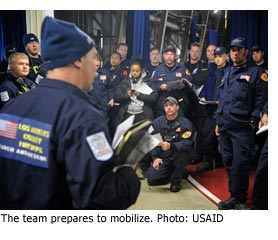 No sooner had they returned from their post-earthquake work in Christchurch, New Zealand than they were summoned to Japan less than 36 hours later to help with the aftermath of the deadly quake and tsunami there.
No sooner had they returned from their post-earthquake work in Christchurch, New Zealand than they were summoned to Japan less than 36 hours later to help with the aftermath of the deadly quake and tsunami there.
“That is a first for us as a team,” said Battalion Chief Tom Ewald, who between disaster assignments heads up the county Fire Department’s Battalion 3, serving East Los Angeles and nearby communities.
The back-to-back deployments made for some joking around on the tarmac as the team—formally known as California Task Force 2—came back from mission No. 2.
“Let’s make it more than 36 hours this time before seeing each other again,” they told each other before heading home at last.
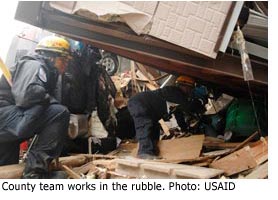 But the lessons learned on both missions are no laughing matter. And they hit close to home for members of the team because both New Zealand and Japan are affluent, highly-developed countries with many similarities to Southern California.
But the lessons learned on both missions are no laughing matter. And they hit close to home for members of the team because both New Zealand and Japan are affluent, highly-developed countries with many similarities to Southern California.
“We write off a lot of the lessons learned in underdeveloped countries,” such as Haiti, Ewald said, because of stark differences in building codes and other factors.
This time, “some of the takeaway was how these types of disasters would have impacted Los Angeles County.”
“Christchurch looks just like downtown Pasadena, or Long Beach,” he said. And as for the tsunami that devastated Japan: “Their only crime there was having exposure to a coastline, which we also have…How would we respond if that kind of widespread, catastrophic event had happened here?
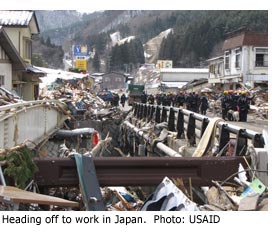 “The skills we learned there are directly transferable.”
“The skills we learned there are directly transferable.”
Ewald said both incidents point up the need to further hone disaster planning and preparedness in Los Angeles, and suggest that a “decentralized decision-making” process may be required in the event of a massive catastrophe like that experienced in Japan.
On a personal level, Ewald—who managed to grab the time to watch “American Idol” with his family between deployments—took advantage of some rare down time early in the week to drop out of sight, as far as work was concerned.
“I kind of kept myself below the radar,” he said. “My cup runneth over.”
California Task Force 2 returned home from Japan on Saturday, March 19. This YouTube video captures the homecoming, as does this CBS Channel 2 video. An array of still images showing the team’s work in Japan and New Zealand is on Facebook. And a National Public Radio report is here.
Posted 3/23/11
Colleges making the grade with bikes
March 24, 2011
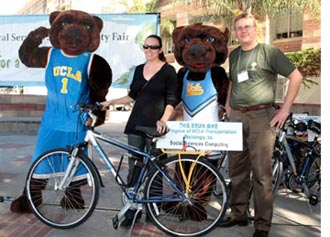 There may be no better way to keep off the dreaded “freshman fifteen” than by cycling to class, and that’s just one of the reasons that students and universities across the country are pushing hard to make their campuses more bike-friendly.
There may be no better way to keep off the dreaded “freshman fifteen” than by cycling to class, and that’s just one of the reasons that students and universities across the country are pushing hard to make their campuses more bike-friendly.
Westwood’s own UCLA is one of twenty schools nationwide that have earned a place on the inaugural “Bicycle Friendly Universities” list, recently announced by the League of American Bicyclists. Five other schools from California also earned the distinction, with Stanford University awarded the “Platinum” medal for being the most bicycle friendly university nationwide. Four of the schools on the list are part of the University of California system.
LAB is a Washington, D.C.-based group that has advocated for cyclists since their main roadway competition was the horse and buggy. Their first major effort was the Good Roads Movement of 1880, which spurred the creation of a system of paved roads that would be easier on cyclists than the existing bumpy, horse-pocked dirt roads. In doing so, they literally paved the way for the automobile. Through an ironic twist of historical fate, they now struggle against the horseless carriage for wiggle room on the very system of roads they helped to create.
LAB’s Bicycle Friendly University program represents an attempt to turn back the clock on our car-dominated culture for the sake of the future. The use of bicycles to combat gas-guzzling automobiles is gaining steam these days. L.A. County’s first Master Bike Plan in 36 years is now in the works, and the city of L.A. just approved its own plan.
LAB’s program looks at the design of the schools and surrounding community to see how bikes are physically accommodated with lanes, parking and signage. It also evaluates institutional offerings such as bike safety classes, programs and organizations that reward cycling, cooperation with law enforcement, and plans for the future.
UCLA achieved a bronze-level distinction in a city where people often accept traffic jams as an unavoidable part of daily life. Among the campus programs that helped the Bruins earn this achievement is the Bike Library, a program where students can rent a bike for the entire quarter for only $35. The program has been wildly successful, and UCLA plans to expand it in the fall. There also is an on-campus bike shop for quick minor repairs, and campus bike routes ease bike commuters in their travels.
Posted 3/24/11
Bus me out to the ballgame
March 23, 2011
Don’t get beaned by traffic this baseball season—take the Dodger Stadium Express.
Metro is providing direct bus service from Union Station to Dodger Stadium beginning with the March 28 preseason matchup with the Anaheim Angels and continuing through all 81 home games (we won’t jinx the playoffs just yet).
Game and season ticket holders ride for free; all others pay $1.50 each way. Rides will depart every 10 minutes in the 90 minutes pre-game, and every 30 minutes throughout the game and for 45 minutes after the final out.
The Dodger Stadium Express, now in its second year, is funded by the Mobile Source Air Pollution Review Committee (MSRC), a group dedicated to reducing motor vehicle air pollution along the SoCal coast.
New to the program this year, Metrolink is providing special late trains for night games. They depart from Union Station at 11 p.m. to Ventura County, San Bernardino County, and the Antelope Valley. The cost of the Metrolink trains ranges from $8 to $10 depending on how far you need to go.
Take the express bus on game day and you will save on parking as well as gas. General parking at the Stadium starts at $15 per car. Consider planning your whole excursion with Metro so you can focus on other things, like how you’re going to digest all those Dodger Dogs.
Posted 3/24/11
Calling all junior nature lovers
March 22, 2011
Will kids go wild for a machine that mimics the mouth of a pill bug? How durable should a soil sifter be if you want it to last for more than a field trip or two? Will people examine a compost pile without an invitation?
Inquiring minds at the Natural History Museum of Los Angeles County want to know.
In less than a month, the museum’s wildly popular Butterfly Pavilion will open for the spring and summer. In past years, the action has all been inside, in the fluttering realm of some 55 species of moths and butterflies.
But this April 10 when the Pavilion opens, the creatures with wings won’t be the only ones under observation. In an effort to perfect displays planned for the new North Campus gardens that will open in 2013 at the museum, an assortment of prototype gadgets and interactive science exhibits will be tested throughout the summer in the outdoor space around the greenhouse-like structure.
And museum workers are looking to visitors, young and old, for help.
“We’ll be making observations on how people use these interactive exhibits,” says Lila Higgins, the museum’s manager of citizen science and live animals. “We’ll be talking to visitors, listening to their feedback.”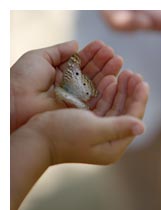
New displays will be set up, one or two at a time, to see how visitors use them and to pinpoint aspects that need tweaking. Pint-sized focus group (aka kids) are especially invited to weigh in.
Museum officials hope the new garden—part of a sweeping renovation that began last year with the “Age of Mammals” exhibition and that this summer will double the museum’s dinosaur exhibits with a new Dinosaur Hall—will teach visitors more about Southern California’s natural environment and give the museum experience a novel outdoor component. Proposed areas include a Home Garden with vegetables and fruit, an Urban Wilderness featuring many native California flora and fauna and a “Get Dirty Zone” where kids can, for example, play in a dirt pile.
Interactivity, however, is considered to be key, and museum staffers have spent months brainstorming ideas for displays, Higgins says.
“I personally love looking through compost piles and finding little beetles and grubs in there,” she says, “but will other people want to do that?
Ideas that have made it to the prototype stage include a butterfly counter, a periscope that will give children a birds-eye view of the landscape, a gizmo that will let kids sift soil and—dear to Higgins’ heart—a heart machine that will demonstrate how pill bugs break down leaves to help create compost.
“Everybody knows that worms aerate the soil, but not everyone knows what pill bugs do,” says Higgins. “So we were all around the table, with ideas flying around, and we knew we were going to have this Get Dirty Zone, and so we started talking about what pill bugs do. Well, they shred leaves. So what if a kid could have the chance to be like a pill bug? Maybe turn a crank and see that a pill bug’s mouth is like a leaf shredder?”
Within a few months, they had a prototype from Cinnabar California Inc, the Los Angeles firm that designed and built the Age of Mammals exhibit. Devised so that children as young as 5 can access it, it’s a metal mechanism in a wooden box that demonstrates the mechanics of the bug’s mouth.
“I don’t know if I’ve seen anything like it anywhere in the world,” says Higgins. “Maybe it’s a bit wacky, but the first time I saw the mock-up—well, when I see a kid use it, I’m going to be so excited.”
Posted 3/22/11
Fire rescue team airborne again
March 11, 2011
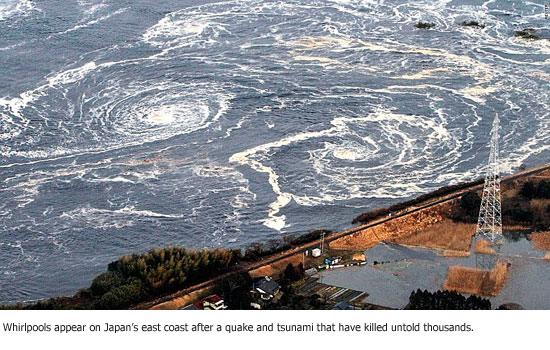 The Los Angeles County Fire Department’s acclaimed rescue team, just days removed from digging through earthquake rubble in New Zealand, is now being dispatched a world away, to the devastated shores of Japan.
The Los Angeles County Fire Department’s acclaimed rescue team, just days removed from digging through earthquake rubble in New Zealand, is now being dispatched a world away, to the devastated shores of Japan.
“You reset, refocus and start planning,” said Battalion Chief Thomas Ewald, who just returned from New Zealand himself and will be helping to coordinate from here the 74-person team’s rescue efforts in Japan, where the death toll from a monstrous earthquake and tsunami is mounting by the minute.
The Fire Department’s California Task Force 2 is only one of two urban search and rescue teams in the country regularly pressed into action by the U.S. aid agency’s Office of Foreign Disaster Assistance. The other is the Fairfax County Fire and Rescue Department. The two had distinguished themselves as the nation’s best.
In a memo to the Board of Supervisors on Friday, newly named Fire Chief Daryl L. Osby wrote: “It is a source of great pride for our organization to not only have this highly specialized response capability but to be called into duty by USAID to help save lives and property beyond our borders.”
The mission at hand differs substantially from those undertaken in the wake of earthquakes in New Zealand and in Haiti, where the team earned international praise for its work in finding and freeing residents trapped for days under buildings. This one will include a swift water rescue component because of the massive tsunami flooding.
Battalion Chief Ewald said that team members, who’ll be transporting with them inflatable rescue boats, have trained for this kind of challenging work at a variety of far-flung locations, including the Colorado River, a Department of Water and Power facility in Sylmar and the Roaring Rapids ride at Six Flags Magic Mountain in Valencia.
“This lets us put people into a controlled swift water environment,” Ewald said of the amusement park training.
The team is scheduled to leave Los Angeles International Airport tonight on a commercial charter flight that will also carry the rescue squad from Virginia.
Posted 3/11/11
A new kind of green incentive
March 10, 2011
 Sure, you consider yourself an environmentally conscious consumer doing all you can to reduce your carbon footprint. But spending a few dollars on recyclable grocery bags is one thing, undertaking a costly upgrade of your home to make it more energy efficient is quite another.
Sure, you consider yourself an environmentally conscious consumer doing all you can to reduce your carbon footprint. But spending a few dollars on recyclable grocery bags is one thing, undertaking a costly upgrade of your home to make it more energy efficient is quite another.
Now, however, Los Angeles County can help you put your wallet where your heart is.
The county’s Office of Sustainability is rolling out a program called Energy Upgrade California, designed to reward homeowners with rebates and incentives when they make green improvements to their homes. The program’s goal is to retrofit 18,000 homes while creating 2,000 green-collar jobs and reducing greenhouse gas emissions by 20,000 metric tons.
To drum up interest and participation, a Home Energy Makeover Contest will be held this spring, with winners receiving up to $50,000 worth of energy upgrades to their homes.
Energy Upgrade California—an alliance between L.A. County, cities within the county, Southern California Edison and Southern California Gas Company—is being underwritten by funds from the American Recovery and Reinvestment Act (ARRA). The program advocates a “whole house” approach designed to maximize energy savings in both dollars and kilowatts.
Homeowners can take advantage of the program simply by registering online. Energy Upgrade and its partners take it from there.
First, contractors meet with homeowners and conduct a computer modeling of their houses to determine the most efficient and effective level of upgrades. The contractors then make the actual improvements and apply for all government and utility rebates on behalf of the customers. These basic upgrades usually include everything from sealing windows to insulating walls to installing energy efficient water heaters and fixtures.
Additional home upgrades are available upon request, including solar power installations or “green upgrades” that will certify the eco-friendliness and efficiency of your home with a GreenPoint rating.
The initial cost of upgrades can range from $2,000 for a basic package to $8,000-$15,000 for an advanced one. Rebates can total up to $4,500 depending on how much work you have done and how much energy is saved. For the truly committed, spending about $50,000 will bring a house close to zero energy consumption.
Between the rebates and savings from reduced utility bills, it’s possible to partially or completely recoup the initial investment. For $1,000 in improvements (after rebates) it is expected that a homeowner will save 10% in utility costs. The market value of your house will also improve. For more complete examples and explanations see “Meet the Sanchez Family” on Energy Upgrade’s website, or watch their video vignette.
Contractors who want to participate in the program must complete a training workshop, and meet other requirements. To perform services beyond basic house-sealing and insulation, they must be certified by the Building Performance Institute (BNI), a nonprofit organization that works with the Department of Energy and the Environmental Protection Agency to develop home energy efficiency methods.
Meanwhile, to enter the Home Energy Makeover Contest, visit the website by March 31 and be ready with your name, address, phone number, utility provider, information about your home and last years’ utility bills. You must be over 21 to enter and own a home located in Los Angeles County.
Winners will be selected based on their capacity to save energy and serve as examples for future energy-saving homeowners. Five winners will be selected to receive $10,000 each in free improvements. One grand prize winner will receive $50,000 worth of improvements. Complete details on eligibility and prizes are available online.
Energy Upgrade California represents the latest in a nationwide push to protect the environment and create sustainable jobs. There have been some setbacks along the way, but with cooperative efforts like this we may be able to preserve our planet and our pocketbooks at the same time.
Posted 3/10/11
County gets rolling on a new bike plan
March 10, 2011
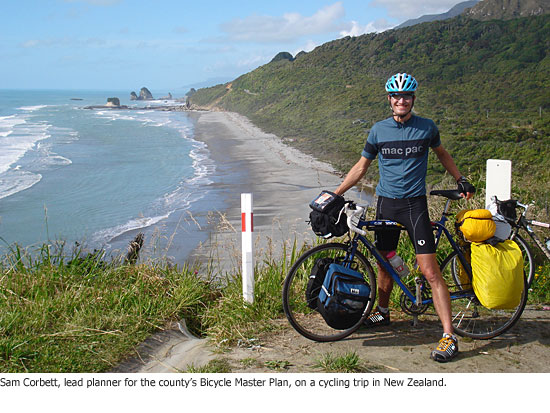 The last time Los Angeles County created a bicycle plan, disco was king, “Jaws” was chewing up the box office and Chevy Chase was channeling Gerald Ford on “Saturday Night Live.”
The last time Los Angeles County created a bicycle plan, disco was king, “Jaws” was chewing up the box office and Chevy Chase was channeling Gerald Ford on “Saturday Night Live.”
Times change, and so has Los Angeles bike culture. Now the county’s jumping into the cycling revolution with both wheels.
A newly drafted Bicycle Master Plan, the county’s first since 1975, puts forth a wide-ranging new blueprint for cycling in Los Angeles County that includes the creation of 695 miles of new bikeways in unincorporated territory over the next two decades, including 20 miles of rider-friendly “bike boulevards.” Nearly 300 miles of the new bikeways would be dedicated bicycle paths and lanes, while the rest would fall under the category of “bicycle route,” in which signage and, potentially, pavement markings, would designate preferred cyclist thoroughfares.
The plan as drafted also contains a range of policy and program recommendations, including support for new “end-of-trip” facilities for cyclists to stow bikes and maybe take a shower; a push for a county “healthy design ordinance”; proposals to make roads safer for cyclists; a recommendation to add bicycles to the county’s transportation fleet; and an endorsement of bicycling as a valid, and growing, transportation option that makes people and communities healthier and more environmentally-friendly.
“It’s a sweeping document in that it provides a vision,” said Abu Yusuf, the county’s bikeway coordinator. “We’re trying to be very proactive.” He said the draft plan is as much about human behavior as it is about infrastructure: “If people aren’t motivated to use the bikeways and to feel safe doing so, they’re not going to use the facilities.”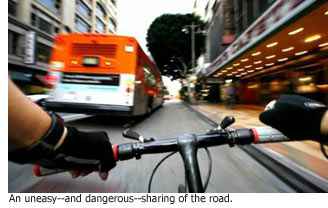
The plan goes out for a final round of public comments later this month. Once those comments are integrated into the document, the plan, if adopted by the Planning Commission and Board of Supervisors, would become part of the county’s General Plan.
The action on the county bike plan comes as Los Angeles rides a huge wave of cycling activism. The city, to great acclaim, recently approved a new bicycle plan that aims to add 1,680 miles of new bikeways. Bicycle advocates have also pushed for greater law enforcement attention to motorists who hit cyclists, for “sharrows” markings to make it clearer that cars need to share the streets with their two-wheeled brethren, and for bike-friendly amenities like a new “bike corral” in Highland Park and “open street” events like CicLAvia.
“The cyclists have come out of the woodwork, so to speak, in the last 18 months and demanded that government do better. And the county is doing better,” said George Wolfberg, a member of the county’s bicycle advisory committee, which helped prepare the draft plan.
Sam Corbett, a senior associate with Alta Planning + Design, which created the bicycle plan draft for the county’s Department of Public Works, said street-level efforts in Los Angeles are part of a larger national picture.
“I’ve found that grassroots activism plays a critical role in pushing the agenda and elevating the importance of bicycling issues in Los Angeles and in other cities throughout the country,” Corbett said. “Without advocates and concerned citizens’ requests for more bicycle-friendly policies, programs and facilities, there’s no question that we wouldn’t have seen as much progress in the past 10-15 years throughout the country in improving bicycling conditions.”
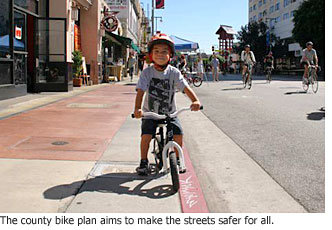 The county plan proposes adding four kinds of bikeways at a cost of $284.8 million over the next 20 years. Those include some 69 miles of “Class 1” car-free bike paths that would be created in unincorporated pockets across the county, with the largest stretches in the San Gabriel and Santa Clarita valleys. There also would be nearly 225 miles of “Class 2” bicycle lanes, with dedicated space for cycling painted onto roadways throughout unincorporated Los Angeles County.
The county plan proposes adding four kinds of bikeways at a cost of $284.8 million over the next 20 years. Those include some 69 miles of “Class 1” car-free bike paths that would be created in unincorporated pockets across the county, with the largest stretches in the San Gabriel and Santa Clarita valleys. There also would be nearly 225 miles of “Class 2” bicycle lanes, with dedicated space for cycling painted onto roadways throughout unincorporated Los Angeles County.
And the plan calls for creation of more than 380 miles of “Class 3” bicycle routes—primarily in the Antelope and Santa Clarita valleys, but also through the Santa Monica Mountains.
“Don’t get too excited about that, unfortunately,” said Tom Foote, a lawyer who regularly commutes from his Topanga home to his office in Santa Monica. Foote, a member of the bicycle advisory committee that consulted on the report, said no one should expect to wake up one day to find a dedicated bike lane running through the mountains; the topography would make it tough, if not impossible, to widen roads sufficiently.
However, the bicycle route designation would mean bicycle signage and possibly shared lane markings in some areas, and would require future planners to consider bicycle needs when they work on roads in the future.
Finally, the report advocates creating 20 miles of “bicycle boulevards” in the San Gabriel Valley and the county’s central, urban core. Such boulevards—with “calming” features such as traffic circles, along with signage and shared lane markings, added to streets that already have low automobile volumes—have proven popular with families and other riders in places like Berkeley, Corbett said.
The plan covers all of unincorporated Los Angeles county, with nearly 2,657 square miles comprising 65% of the county’s total land but home to just 11% of its population. The sheer size poses difficulties for bicycle planners.
“The challenge in a lot of the county is that it’s vast. There’s a huge amount of space,” Corbett said, noting that while trips of 5 miles or less can be enticing to a would-be cyclist, 15- to 20-mile voyages in places like the Antelope Valley can be daunting.
Another obstacle comes from Los Angeles’ entrenched car culture. “Politically and just practically, it can be challenging to put in bikeway facilities,” Corbett said.
To help overcome those challenges, the plan marshals an array of environmental, health and safety information to make the case for thoroughly integrating bicycles onto Los Angeles streets that have long been considered—by some—to be the exclusive domain of automobiles.
Among its findings:
Streets must be made safer for cyclists. There were 1,307 collisions involving bicycles reported in unincorporated county areas from 2004-2009. Many of those—228—took place in East Los Angeles. On the Westside, there were 56 crashes, with the vast majority (37) occurring in Marina del Rey. “Bar none, safety is the No. 1 concern that citizens have with cycling,” Corbett said. Helping people overcome those fears through education and better design puts more cyclists safely on the streets, the report said.
Bicycling is the green transportation choice. By 2035, increased bicycle use is expected to reduce the number of vehicle trips in unincorporated areas by more than 6 million a year, reducing emissions of hydrocarbons, carbon dioxide and other substances linked to climate change and smog.
Cycling is a public health issue. Bicycle-friendly communities contribute to improved public health by encouraging physical activity and helping to combat chronic diseases such as diabetes and heart disease.
Riding is a lot cheaper than driving. The report said cyclists’ annual operating costs run just 1.5% to 3.5% of motorists’ expenses. (An argument that seems likely to get more persuasive as gas prices move north of $4 a gallon.)
In undertaking its first bike master plan in 36 years, the county has to make up for lost time, and lost funding opportunities. The biggest state source of funding for commuter bike facilities requires master plan updates every five years, Corbett said.
The bike master plan puts the county back in the game—lagging behind places like Portland, New York and even Long Beach, but ready to roll. “It’s undoubtedly a big advance over the last master plan, which is ancient and completely outdated,” Foote said.
“This is a major document,” added Yusuf. “It provides a vision for what the county wants to do.”
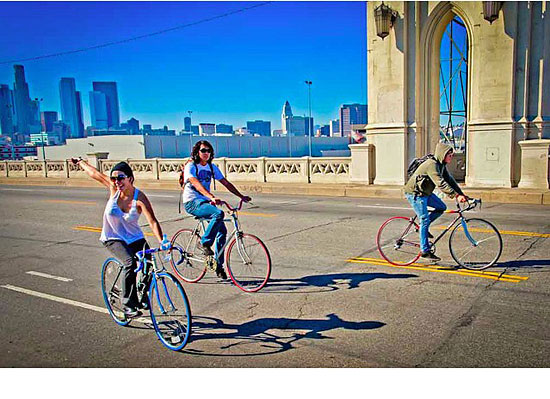 Public workshops on the county’s Bicycle Master Plan begin March 28 at 6 p.m. at the Topanga Elementary School. For a list of meeting times and locations, click here.
Public workshops on the county’s Bicycle Master Plan begin March 28 at 6 p.m. at the Topanga Elementary School. For a list of meeting times and locations, click here.
Posted 3/10/11




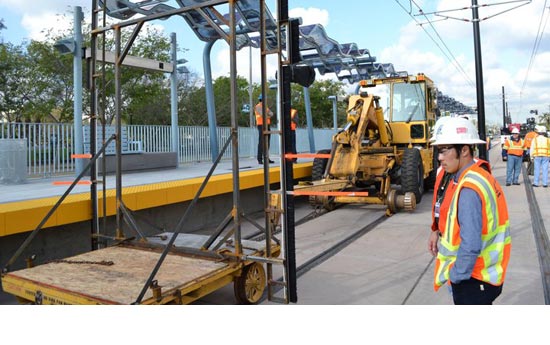
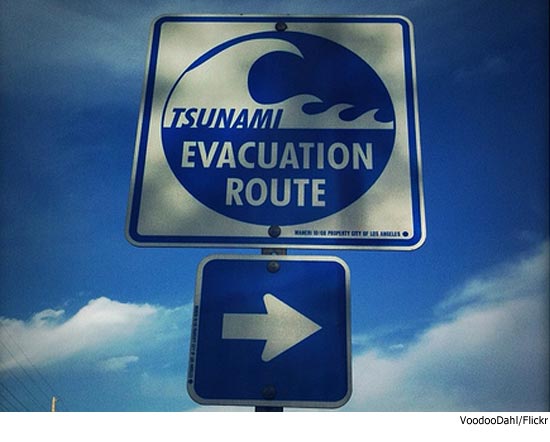
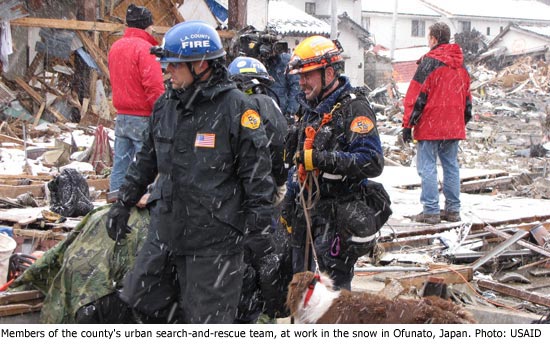
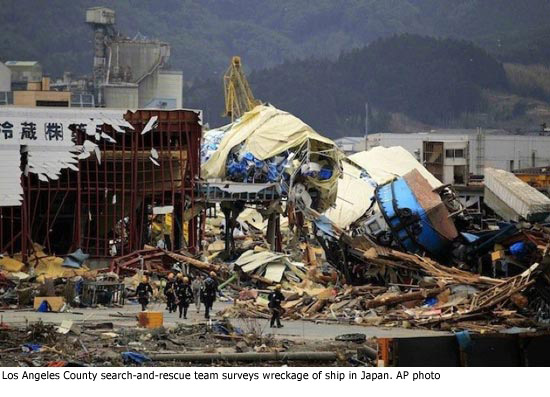
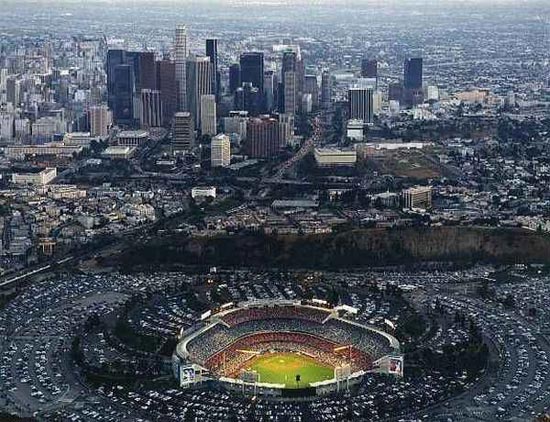
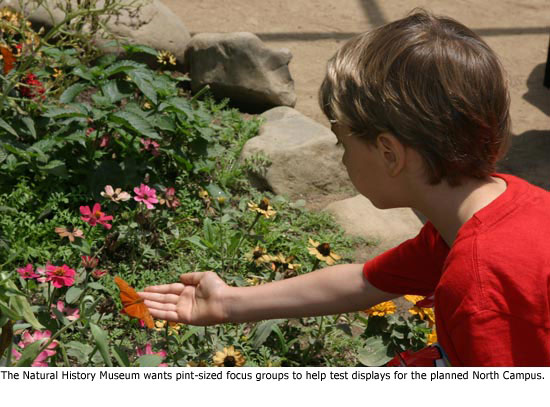
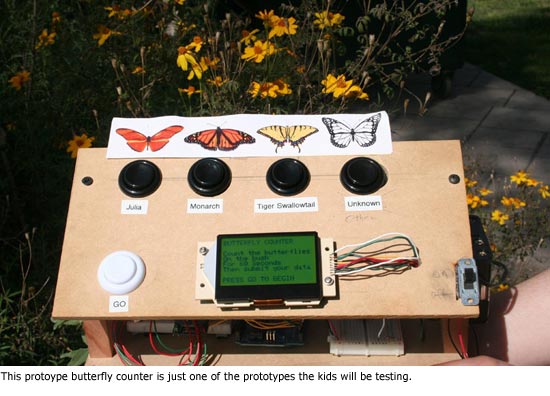
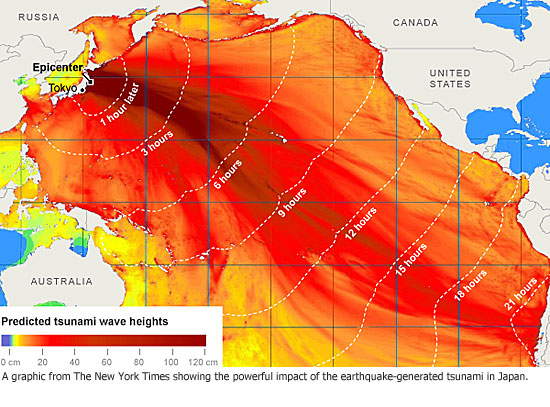





 Check for the latest closure information
Check for the latest closure information








